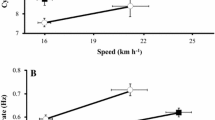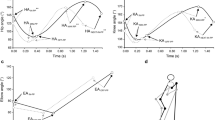Abstract
Purpose
We investigated the effects of poling on physiological, kinematic and kinetic responses in the G4 skating technique where the poling movement is synchronized with the leg push-off on one side (strong side) followed by a forward arm swing during the leg push-off on the other side (weak side).
Methods
G4 skating with (G4-P) and without (G4-NP) poling was compared in 17 elite male cross-country skiers during 4-min submaximal tests on a 2 % inclined roller ski treadmill at 10, 15 and 20 km h−1.
Results
G4-P demonstrated less ventilatory stress and higher gross efficiency compared to G4-NP at all velocities, and the blood lactate concentration was lower at the high velocity (all P < 0.05). Furthermore, longer cycle lengths and lower cycle rates were found with G4-P at all velocities, with correspondingly lower peak ski forces, increased ski velocities and less angling and edging of the skis (all P < 0.05). The peak ski forces on the strong side were lower than on the weak side with G4-P at all velocities (all P < 0.05), but no differences between the sides were found with G4-NP.
Conclusions
The reduced physiological cost, higher gross efficiency and longer cycle lengths together with the lower ski forces at a given work rate with G4-P demonstrate the effectiveness of poling in the G4 skating technique. Thus, poling provides possibilities to increase total propulsion, to reduce ski forces and to enhance skiing efficiency.






Similar content being viewed by others
Abbreviations
- F f :
-
Friction force
- F n :
-
Normal force
- g :
-
Gravitational acceleration
- G3:
-
A skating technique, also referred to as V1 or Double Dance, that involves one double poling action for each leg push-off
- G4/G4-P:
-
A skating technique, also referred to as V2-alternate or Open Field Skate, that involves one double poling action for two leg push-offs
- G4-NP:
-
Simulation of the G4 skating technique without poles
- m :
-
Body mass
- PF:
-
Pole force component
- P f :
-
Power against friction
- P g :
-
Power against gravity
- RER:
-
Respiratory exchange ratio
- RPE:
-
Rating of perceived exertion
- v :
-
Velocity of the treadmill belt
- VCO2 :
-
Carbon dioxide consumption
- VO2 :
-
Oxygen consumption
- α :
-
Incline
- µ :
-
Friction coefficient
References
Ainegren M, Carlsson P, Tinnsten M (2008) Roller ski rolling resistance and its effects on elite athletes’ performance (P225). engineering of sport 7, Vol 2. pp 393–400
Bilodeau B, Rundell KW, Roy B, Boulay MR (1996) Kinematics of cross-country ski racing. Med Sci Sports Exerc 28(1):128–138
Borg G (1970) Perceived exertion as an indicator of somatic stress. Scand J Rehabil Med 2(2):92–98
Hoffman MD, Kassay KM, Zeni AI, Clifford PS (1996) Does the amount of exercising muscle alter the aerobic demand of dynamic exercise? Eur J Appl Physiol Occup Physiol 74(6):541–547
Hollman JH, Brey RH, Bang TJ, Kaufman KR (2007) Does walking in a virtual environment induce unstable gait? An examination of vertical ground reaction forces. Gait Posture 26(2):289–294
Holmberg HC, Lindinger S, Stoggl T, Eitzlmair E, Muller E (2005) Biomechanical analysis of double poling in elite cross-country skiers. Med Sci Sports Exerc 37(5):807–818
Hoset M, Rognstad AB, Rølvåg T, Ettema G, Sandbakk O (2014) Construction of an instrumented roller ski and validation of three-dimensional forces in the skating technique. Sports Eng 17:23–32
Medbo JI, Mamen A, Holt Olsen O, Evertsen F (2000) Examination of four different instruments for measuring blood lactate concentration. Scand J Clin Lab Invest 60(5):367–380
Millet GY, Hoffman MD, Candau RB, Clifford PS (1998) Poling forces during roller skiing: effects of technique and speed. Med Sci Sports Exerc 30(11):1645–1653
Pellegrini B, Bortolan L, Schena F (2011) Poling force analysis in diagonal stride at different grades in cross country skiers. Scand J Med Sci Sports 21(4):589–597
Peronnet F, Massicotte D (1991) Table of nonprotein respiratory quotient: an update. Can J Sport Sci 16(1):23–29
Rundell KW, McCarthy JR (1996) Effect of kinematic variables on performance in women during a cross-country ski race. Med Sci Sports Exerc 28(11):1413–1417
Sandbakk O, Holmberg HC, Leirdal S, Ettema G (2010) Metabolic rate and gross efficiency at high work rates in world class and national level sprint skiers. Eur J Appl Physiol 109(3):473–481
Sandbakk O, Ettema G, Holmberg HC (2012) The influence of incline and speed on work rate, gross efficiency and kinematics of roller ski skating. Eur J Appl Physiol 112(8):2829–2838
Sandbakk O, Ettema G, Holmberg HC (2013) The physiological and biomechanical contributions of poling to roller ski skating. Eur J Appl Physiol. doi:10.1007/s00421-013-2629-4
Smith GA (1992) Biomechanical analysis of cross-country skiing techniques. Med Sci Sports Exerc 24(9):1015–1022
Stoggl TL, Muller E (2009) Kinematic determinants and physiological response of cross-country skiing at maximal speed. Med Sci Sports Exerc 41(7):1476–1487
Stoggl T, Kampel W, Muller E, Lindinger S (2010) Double-push skating versus V2 and V1 skating on uphill terrain in cross-country skiing. Med Sci Sports Exerc 42(1):187–196
Van Hall G, Jensen-Urstad M, Rosdahl H, Holmberg HC, Saltin B, Calbet JA (2003) Leg and arm lactate and substrate kinetics during exercise. Am J Physiol Endocrinol Metab 284(1):E193–E205
Acknowledgments
The authors would like to thank; Martin Hoset and Asgeir Rognstad for their help with data collection and analysis, Christina Åsan Grasaas and Knut Skovereng with assistance during testing, and the participants and their coaches for their enthusiastic cooperation. The Norwegian Olympic Committee financially supported this study.
Conflict of interest
There are no conflicts of interest.
Author information
Authors and Affiliations
Corresponding author
Additional information
Communicated by Jean-René Lacour.
Rights and permissions
About this article
Cite this article
Grasaas, E., Hegge, A.M., Ettema, G. et al. The effects of poling on physiological, kinematic and kinetic responses in roller ski skating. Eur J Appl Physiol 114, 1933–1942 (2014). https://doi.org/10.1007/s00421-014-2926-6
Received:
Accepted:
Published:
Issue Date:
DOI: https://doi.org/10.1007/s00421-014-2926-6




